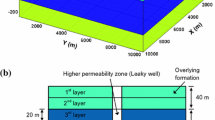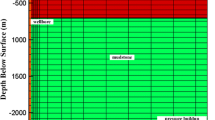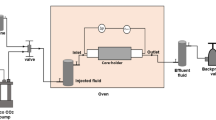Abstract
CO2 injection in saline aquifers induces temperature changes owing to processes such as Joule–Thomson cooling, endothermic water vaporization, exothermic CO2 dissolution besides the temperature discrepancy between injected and native fluids. CO2 leaking from the injection zone, in addition to initial temperature contrast due to the geothermal gradient, undergoes similar processes, causing temperature changes in the above zone. Numerical simulation tools were used to evaluate temperature changes associated with CO2 leakage from the storage aquifer to an above-zone monitoring interval and to assess the monitorability of CO2 leakage on the basis of temperature data. The impact of both CO2 and brine leakage on temperature response is considered for three cases (1) a leaky well co-located with the injection well, (2) a leaky well distant from the injector, and (3) a leaky fault. A sensitivity analysis was performed to determine key operational and reservoir parameters that control the temperature signal in the above zone. Throughout the analysis injection-zone parameters remain unchanged. Significant pressure drop upon leakage causes expansion of CO2 associated with Joule–Thomson cooling. However, brine may begin leaking before CO2 breakthrough at the leakage pathway, causing heating in the above zone. Thus, unlike the pressure which increases in response to both CO2 and brine leakage, the temperature signal may differentiate between the leaking fluids. In addition, the strength of the temperature signal correlates with leakage velocity unlike pressure signal whose strength depends on leakage rate. Increasing leakage conduit cross-sectional area increases leakage rate and thus increases pressure change in the above zone. However, it decreases leakage velocity, and therefore, reduces temperature cooling and signal. It is also shown that the leakage-induced temperature change covers a small area around the leakage pathway. Thus, temperature data will be most useful if collected along potential leaky wells and/or wells intersecting potential leaky faults.








Similar content being viewed by others
References
Andre L, Azaroual M, Peysson Y, Bazin B (2011) Impact of porous medium desiccation during anhydrous CO2 injection in deep saline aquifers: up scaling from experimental results at laboratory scale to near-well region. Energy Proced 4:4442–4449. doi:10.1016/j.egypro.2011.02.398
André L, Azaroual M, Menjoz A (2010) Numerical simulations of the thermal impact of supercritical CO2 injection on chemical reactivity in a carbonate saline reservoir. Transp Porous Media 82(1):247–274. doi:10.1007/s11242-009-9474-2
Bakker RJ (2003) Package FLUIDS 1. Computer programs for analysis of fluid inclusion data and for modelling bulk fluid properties. Chem Geol 194(1–3):3–23
Bielinski A, Kopp A, Schutt H, Class H (2008) Monitoring of CO2 plumes during storage in geological formations using temperature signals: numerical investigation. Int J Greenhouse Gas Cont 2(3):319–328. doi:10.1016/j.ijggc.2008.02.008
API Technical Data Book, Petroleum Refining (1983) 4th edn. Washington
Canjar LN, Manning FS (1967) Thermodynamic properties and reduced correlations for gases. Gulf Publishing Co., Houston
Carman PC (1956) Flow of gases through porous media. Butterworths, London 1
CMG-GEM (2012) CMG-GEM version 2012 user’s guide. Computer modelling group Ltd. http://www.cmgl.ca/software/gem.htm
Han WS, Stillman GA, Lu M, Lu C, McPherson BJ, Park E (2010) Evaluation of potential nonisothermal processes and heat transport during CO2 sequestration. J Geophys Res 115(B7):B07209. doi:10.1029/2009JB006745
Han W, Kim K-Y, Park E, McPherson B, Lee S-Y, Park M-H (2012) Modeling of spatiotemporal thermal response to CO2 injection in saline formations: interpretation for monitoring. Transp Porous Media 93(3):381–399. doi:10.1007/s11242-012-9957-4
Harvey AH (1996) Semiempirical correlation for Henry’s constants over large temperature ranges. AIChE J 42(5):1491–1494. doi:10.1002/aic.690420531
Henninges J, Huenges E, Burkhardt H (2005) In situ thermal conductivity of gas-hydrate-bearing sediments of the Mallik 5L-38 well. J Geophys Res-Sol Ea 110(B11)
Hoang H, Mahadevan J, Lopez H (2011) Interpretation of wellbore temperatures measured using distributed temperature sensors during hydraulic fracturing. In: SPE hydraulic fracturing technology conference, SPE 140442, Woodlands, TX, 24–26 January 2011
Hovorka SD, Benson SM, Doughty C, Freifeld BM, Sakurai S, Daley TM, Kharaka YK, Holtz MH, Trautz RC, Nance HS, Myer LR, Knauss KG (2006) Measuring permanence of CO2 storage in saline formations: the Frio experiment. Environ Geosci 13(2):105–121. doi:10.1306/eg.11210505011
Hovorka SD, Meckel TA, Treviño RH (2013) Monitoring a large-volume injection at Cranfield, Mississippi—project design and recommendations. Int J Greenhouse Gas Cont 18:345–360
Hurter S, Garnett A, Bielinski A, Kopp A (2007) Thermal signature of free-phase CO2 in porous rocks: detectability of CO2 by temperature logging. In: SPE Offshore Europe, SPE 109007, Aberdeen, Scotland, UK, 4–7 September 2007
Javadpour F, Pooladi-Darvish M, Jeje A, Shen LC (2003) Effect of transient temperature on MWD resistivity logs. Petrophysics 44:435–445
Kim S, Hosseini SA (2013) Above-zone pressure monitoring and geomechanical analyses for a field-scale CO2 injection project in Cranfield, MS. Greenhouse Gas Sci Technol. doi:10.1002/ghg.1388
Koschel D, Coxam JY, Rodier L, Majer V (2006) Enthalpy and solubility data of CO2 in water and NaCl(aq) at conditions of interest for geological sequestration. Fluid Phase Equilib 247(1–2):107–120. doi:10.1016/j.fluid.2006.06.006
Liebscher A, Möller F, Bannach A, Köhler S, Wiebach J, Schmidt-Hattenberger C, Weiner M, Pretschner C, Ebert K, Zemke J (2013) Injection operation and operational pressure–temperature monitoring at the CO2 storage pilot site Ketzin, Germany—design, results, recommendations. Int J Greenhouse Gas Control 15:163–173
Lu M, Connell LD (2008) Non-isothermal flow of carbon dioxide in injection wells during geological storage. Int J Greenhouse Gas Cont 2(2):248–258. doi:10.1016/S1750-5836(07)00114-4
Marinaro G, Etiope G, Gasparoni F, Furlan F, Bruni F (2011) Gas seepage detection and monitoring at seafloor. In: 10th offshore Mediterranean conference and exhibition, Doc. ID 2011-045, Ravenna, Italy, 23–25 March 2011
Mathias SA, Gluyas JG, Oldenburg CM, Tsang CF (2010) Analytical solution for Joule–Thomson cooling during CO2 geo-sequestration in depleted oil and gas reservoirs. Int J Greenhouse Gas Cont 4(5):806–810. doi:10.1016/j.ijggc.2010.05.008
Nogues JP, Nordbotten JM, Celia MA (2011) Detecting leakage of brine or CO2 through abandoned wells in a geological sequestration operation using pressure monitoring wells. Energy Procedia 4:3620–3627
Nuñez-Lopez V, Hovorka SD (2012) Subsurface monitoring of large-scale CO2 injection at SECARBC’s phase III Cranfield Site. In: carbon management technology conference, SPE 151504, Orlando, Florida, USA, 7–9 February 2012
Oldenburg CM (2007) Joule–Thomson cooling due to CO2 injection into natural gas reservoirs. Energy Convers Manage 48(6):1808–1815. doi:10.1016/j.enconman.2007.01.010
Oldenburg CM, Pruess K (1998) Layered thermohaline convection in hypersaline geothermal systems. Transp Porous Media 33(1–2):29–63. doi:10.1023/A:1006579723284
Peng DY, Robinson DB (1976) A new two-constant equation of state. Ind Eng Chem Fundam 15:59–64
Pruess K (2005) TOUGH2 fluid property module for mixtures of water, NaCl, and CO2. Lawrence Berkeley National Laboratory, Berkeley
Pruess K (2011) Integrated modeling of CO2 storage and leakage scenarios including transitions between super- and subcritical conditions, and phase change between liquid and gaseous CO2. Greenhouse Gases Sci Tech 1(3):237–247. doi:10.1002/ghg.24
Pruess K, Oldenburg C, Moridis G (1999) TOUGH2 user’s guide, version 2.0. Report LBNL-43134, Lawrence Berkeley National Laboratory, Berkeley
Reinsch T, Henninges J, Ásmundsson R (2013) Thermal, mechanical and chemical influences on the performance of optical fibres for distributed temperature sensing in a hot geothermal well. Environ Earth Sci 70(8):3465–3480
Satik C, Yortsos YC (1996) A pore-network study of bubble growth in porous media driven by heat transfer. J Heat Transfer 118(2):455–462. doi:10.1115/1.2825866
Saul A, Wagner W (1987) International equations for the saturated properties of ordinary water substance. J Phys Chem Ref Data 16(4):893–901
Singh AK, Baumann G, Henninges J, Görke UJ, Kolditz O (2012) Numerical analysis of thermal effects during carbon dioxide injection with enhanced gas recovery: a theoretical case study for the Altmark gas field. Environ Earth Sci 67(2):497–509
Vinsome PKW, Westerveld J (1980) A simple method for predicting cap and base rock heat-losses in thermal reservoir simulators. J Can Petrol Technol 19(3):87–90
Wang S, Clarens AF (2012) The effects of CO2-brine rheology on leakage processes in geologic carbon sequestration. Water Resour Res 48(8):W08518. doi:10.1029/2011wr011220
Wangen M (1995) The blanketing effect in sedimentary basins. Basin Res 7(4):283–298. doi:10.1111/j.1365-2117.1995.tb00118.x
Zeidouni M (2011) Analytical and inverse models for leakage characterization of CO2 storage, Chapter 5, PhD dissertation, University of Calgary, Calgary, Canada
Zeidouni M, Pooladi-Darvish M (2012) Leakage characterization through above-zone pressure monitoring: 1—inversion approach. J Petrol Sci Eng 98–99:95–106
Zeidouni M, Pooladi-Darvish M, Keith D (2009) Analytical solution to evaluate salt precipitation during CO2 injection in saline aquifers. Int J Greenhouse Gas Cont 3(5):600–611
Zhang YK (1993) The thermal blanketing effect of sediments on the rate and amount of subsidence in sedimentary basins formed by extension (vol 218, pg 297, 1993). Tectonophysics 225(4):551. doi:10.1016/0040-1951(93)90317-D
Acknowledgments
This project was funded in part by EPA STAR grant R834384. The authors wish to thank three anonymous reviewers as well as Axel Liebscher of GFZ German Research Centre for Geosciences for their careful reviews of the manuscript and suggestions for improvements. The authors thank Computer Modelling Group Ltd. for providing the option of free access to the CMG simulation package. Amin Badamchizadeh and Vijay Shrivastava are acknowledged for their help in applying CMG-GEM thermal modeling of CO2 storage. Thank you also to Lana Dieterich who edited the manuscript. Publication authorized by the Director, Bureau of Economic Geology.
Author information
Authors and Affiliations
Corresponding author
Electronic supplementary material
Below is the link to the electronic supplementary material.
Rights and permissions
About this article
Cite this article
Zeidouni, M., Nicot, JP. & Hovorka, S.D. Monitoring above-zone temperature variations associated with CO2 and brine leakage from a storage aquifer. Environ Earth Sci 72, 1733–1747 (2014). https://doi.org/10.1007/s12665-014-3077-0
Received:
Accepted:
Published:
Issue Date:
DOI: https://doi.org/10.1007/s12665-014-3077-0




